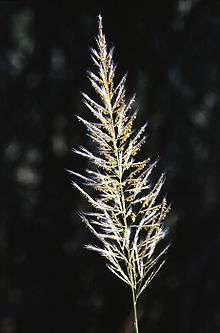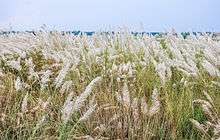Saccharum spontaneum
| Kans grass | |
|---|---|
 | |
| Scientific classification | |
| Kingdom: | Plantae |
| (unranked): | Angiosperms |
| (unranked): | Monocots |
| (unranked): | Commelinids |
| Order: | Poales |
| Family: | Poaceae |
| Genus: | Saccharum |
| Species: | S. spontaneum |
| Binomial name | |
| Saccharum spontaneum L. | |

Saccharum spontaneum (wild sugarcane,[1] Kans grass, Bengali: কাশ kash, Hindi: काँस kām̥s, Odia: କାଶତଣ୍ଡି kāśataṇḍi, Assamese: কঁহুৱা, খাগৰী kahuwa, khagori) is a grass native to the Indian Subcontinent. It is a perennial grass, growing up to three meters in height, with spreading rhizomatous roots.[2][3]
In the Terai-Duar savanna and grasslands, a lowland ecoregion at the base of the Himalaya range in Nepal, India, Bangladesh and Bhutan, kans grass quickly colonises exposed silt plains created each year by the retreating monsoon floods, forming almost pure stands on the lowest portions of the floodplain. Kans grasslands are an important habitat for the Indian rhinoceros (Rhinoceros unicornis). In Nepal, kans grass is harvested to thatch roofs or fence vegetable gardens.
Elsewhere, its ability to quickly colonize disturbed soil has allowed it to become an invasive species that takes over croplands and pasturelands.
Uses
Saccharum spontaneum has a considerable number of regional names in the Indian Subcontinent, for instance kash [কাশ] being common in Bengali/Bangla [বাংলা]. Some of these are given, along with Ayurvedic medical properties.[4] [5]
References
- ↑ "Saccharum spontaneum". Natural Resources Conservation Service PLANTS Database. USDA. Retrieved 26 October 2015.
- ↑ http://assamforest.in/publication/wildEdible_plantsAssam.pdf
- ↑ http://assamplants.com/Alphabetical%20%20Order%20(Sc%20Name).htm
- ↑ Pankaj Oudhia (2001-3)
- ↑ http://assamplants.com/All%20Species/Saccharum%20spont.htm
External links
 Data related to Saccharum spontaneum at Wikispecies
Data related to Saccharum spontaneum at Wikispecies
| Wikimedia Commons has media related to Saccharum spontaneum. |
